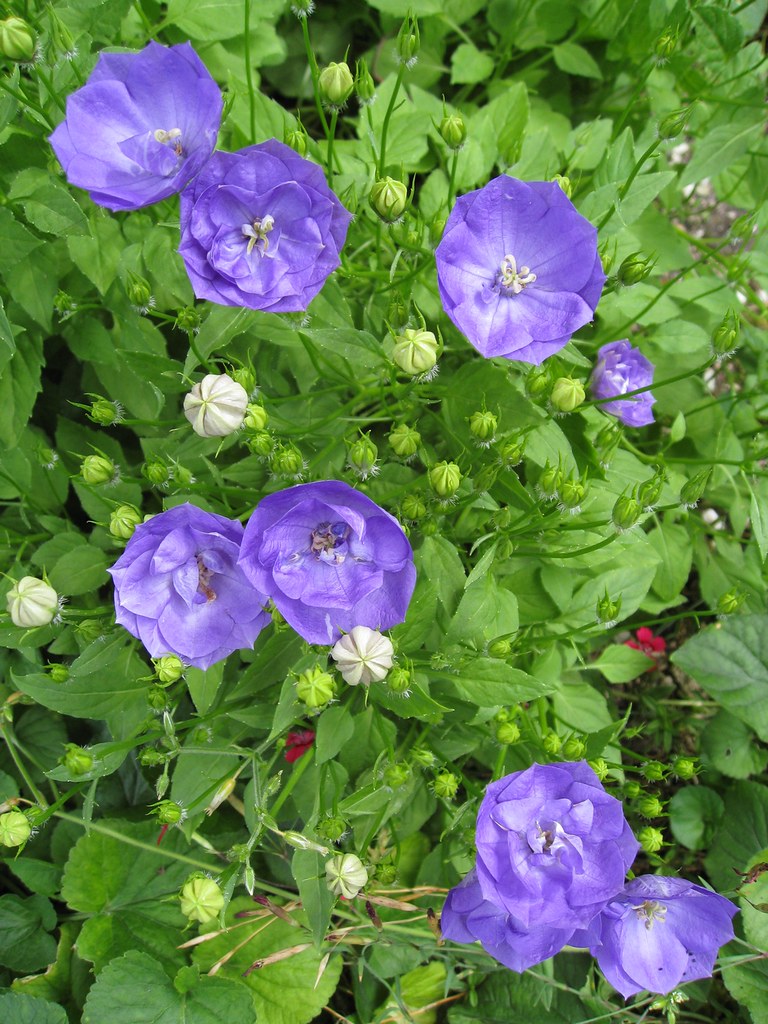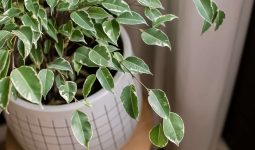Are you looking for some inspiration for your next floral arrangement? Or maybe you want to create something unique for your garden borders? Bell Flowers are beautiful and versatile, and they come in a variety of shapes and colors.
In this article, we shall discuss the different types of bellflowers so that you can have many options to choose from!
1. Carpathian Bellflowers

Carpathian bellflowers come in colors including white, purple, and blue and take a long time to go into full bloom. These captivating blooms thrive in troughs, wall cracks, and rock gardens.
The plant can be started inside and is appropriate for winter sowing. It attracts pollinators like moths, butterflies, bees, flies, and beetles.
You can grow it in containers ranging from one gallon to three gallons. It is capable of growing in poor soil conditions.
In addition, the Carpathian bellflower performs best as a ground cover or cut flower in an Alpine Gardening setting. It’s an excellent flower for landscaping, especially near sidewalks, patios, and driveways.
This flower self-fertilizes but requires a temperature of around 65 degrees Fahrenheit to thrive. It germinates in one to three weeks and has only a surface depth to plant seed.
2. Clustered Bellflower
Among the different types of bellflowers is the clustered bellflower. It is a group of thick violet-blue to white-looking clusters.
These lovely and strong flowers have a distinctive bell-like form and can grow 6 to 24 inches tall and 12 to 36 inches wide.
You can grow this beautiful flower indoors before transplanting it outside in early spring. It requires direct sunlight and does not tolerate shade well. Also, it has everlasting leaves and a lovely purple color.
This flower grows well with a moderate amount of water and has a bloom size of about two inches in diameter. It spreads by underground runners and blooms in early summer or late spring.
Furthermore, the Carpathian bellflower self-germinates after a cold period. It is more suitable for winter sowing and transplanting. If it has water access, it may grow in any soil type.
3. Adriatic Bellflower
This lovely blue groundcover flower requires little water to grow and thrive. It can be found in fields or near a lovely country pond, giving a splash of color to any setting.
It attracts bees, butterflies, and hummingbirds while inviting pollinators like butterflies, moths, bees, flies, and beetles.
This flower can also self-pollinate and be grown indoors during the winter. It is also capable of transplanting. To avoid damaging other delicate plants, keep this plant away from it.
4. Birch-leaved Bellflower
This is also among the different types of bellflowers. Don’t be surprised if you see this flower on a beautiful spring or summer day. It requires full or partial sunlight to develop properly.
In addition, it’s a groundcover flower that you can cut and use in a flower arrangement. It also attracts bees, hummingbirds, and butterflies.
These flowers can withstand being transplanted if you wish to grow them in wintertime.
5. Viking Bellflower
The Viking bellflower is a favorite among hummingbirds. Its purple blossoms can instantly brighten and revitalize your garden.
It is a common choice among garden experts and lovers because it’s low maintenance and peat-free in nature.
6. Korean Bellflower
The Korean bellflower blooms from the beginning of summer to the end of the season. It features light purple-pink blooms with dark spots inside.
Additionally, it is covered in vibrant green leaves that enhance the flower’s overall attractiveness. Depending on where you live, the faintly fragrant blooms require either full or partial sun.
7. Wide-leaved Bellflower
This is also among the different types of bellflowers. It’s suitable for landscaping or growing alongside a driveway.
You can grow it as a cut flower, but that’s if you first stratify the seeds for three weeks. This bellflower also grows well as a ground cover.
Furthermore, it can be transplanted and is good for winter sowing. It blooms in late spring to early summer and attracts bees, butterflies, and hummingbirds. Also, it requires full sun or only partial shade to thrive.
8. Mountain Harebell
This wildflower thrives in rocky soil and is commonly seen near mountains and lakes. It is also known as the Alaska Harebell and requires full sun to partial shade to grow and thrive.
Mountain Harebell requires a reasonable amount of water and has a lovely blue color. It will brighten up any landscape or bouquet. Also, it flowers in late spring or early summer and thrives in Alpine Gardening.
In addition, it is a groundcover that will grow year after year, attracting butterflies, bees, and hummingbirds.
It self-fertilizes, but butterflies, bees, moths, flies, and beetles can also fertilize it. You can grow it indoors in the wintertime and transplant it outside in the spring.
9. Peach-leaved Bellflower
This bellflower doesn’t have a peach color like its name implies. However, it’s a beautiful flower with shades ranging from white to violet.
The peach-leaved bellflower is known as Finland’s most popular wildflower. It’s an evergreen perennial that blooms most of the year, and honeybees, bumblebees, and flies often pollinate it.
10. Spotted Bellflower
Among the different types of bellflowers, the spotted bellflower is also a lovely clump-forming flower with heart-shaped foliage. It’s also a tubular, bell-shaped white or dusty pink flower with red spots.
This flower can reach a height of around a foot and is native to Japan and Siberia. It thrives in partial shade or full sun, also known as the Chinese Rampion.
In addition, it grows and thrives with a reasonable amount of water and is self-fertile.
11. Serbian Bellflower
The Serbian bellflower, also known as the poscharsky’s bellflower or the trailing bellflower, is a pale violet-blue, star-shaped flower about one inch in diameter.
This flower blooms abundantly from late spring to early summer and provides an excellent ground cover for your landscaping.
In addition, it requires a moderate amount of water to survive and can tolerate poor soil conditions. It attracts many insects and self-pollinate. Butterflies, bees, beetles, and moths can also pollinate it.
12. Dalmatian Bellflower
This is one of the different types of bellflowers. It’s a popular flower that can fill the gaps between stepping stones in your garden or walkway and looks lovely flowing over a retaining wall.
They will enhance your landscaping with stunning blue or purple flowers and dark green leaves.
Dalmatian bellflowers are herbaceous perennial flowers that can grow nearly six inches tall and nearly a foot wide. They require a medium quantity of rainfall in well-drained soil and bloom yearly in the spring.
The old leaves begin to wither in the spring as new leaves grow to replace them. To keep your plant looking fresh and new, remove the brown leaves as soon as the new ones grow.
13. Canterbury Bells
Canterbury Bells is a biennial flower plant. It features lovely pink clusters of bell-shaped blooms that grow 12 to 18 inches across and 20 to 26 inches tall. These heart-warming blooms are simple to grow and maintain.
Not only do nature lovers appreciate Canterbury bells, but so do bees, butterflies, and hummingbirds. You’ll see these lovely creatures crawling around Canterbury bells wherever you find them.
14. Bluebell
These vibrant, tiny flowers have lovely trumpet-shaped blooms that dangle freely from core foliage and grow roughly 2-3 feet tall. Because of their slender shape, their flowers have a delicate appearance.
Gardeners adore these summer-blooming flowers for their ability to sway gently in the summer breeze. In addition, bluebells grow well in most soils.
However, because they are originally wild plants, adding some organic matter to their garden will help them bloom faster and live longer.
15. Campanula Lactifora
These milky flowers are also among the different types of bellflowers. They produce stately, star-shaped flowers that are usually a soft lavender color.
Because of their rich color and romantic bloom clusters, they look great as a garden border or alongside a fence.
Also, they keep deer, rabbits, and other garden pests at bay, making them functional and beautiful.
16. Shiny-leaved Bellflower
This spectacular, beautiful groundcover flower was discovered in the Alps. It’s a bellflower that attracts hummingbirds, butterflies, and bees.
Furthermore, this flower is suitable for winter sowing in one-gallon containers. It is ideal for landscaping and requires only a small amount of water to thrive.
17. Spreading Bellflower
Spreading bellflower is native to regions of Europe but has spread much abroad. This lovely groundcover flower grows in meadows, river and stream banks, open woodland regions, and clearings in wooded areas.
You can also find them along country roads, other roadways, fallow fields, and waste ground. Their star-shaped, light violet-blue flowers will add color to your garden.
It grows best in full sun and can be transplanted or winter sown. You can also grow it indoors in containers at least one gallon in size.
18. Kashmir Bellflower
The Kashmir bellflower is among the different types of bellflowers. It thrives in full sun to moderate shade and is an excellent groundcover or cut flower that returns yearly. This flower requires only a reasonable amount of water to grow.
It can be grown indoors in a one-gallon or larger container during winter. Also, it can withstand transplanting with ease.
19. Bearded Bellflower
Bearded Bellflower thrives in full sun or light shade and has a lovely lavender color. It is a little plant that only grows to around an inch in height.
This flower has a taproot and blooms from late spring through early summer. It is great for Alpine Gardening and is a perennial ground cover that attracts bees, hummingbirds, and butterflies. Also, It can be transplanted and is suitable for winter sowing.
20. Marsh Bellflower
Marsh bellflower grows well in damp environments such as swamps or ditches. It is sometimes called a bedstraw bellflower or swamp bellflower. This spectacular, attractive flower functions as a ground cover.
It blooms yearly and may be used as a cut flower in bouquets and centerpieces. It is also good for winter sowing and transplanting and attracts bees, hummingbirds, and butterflies.
21. Alpine Bellflower
The different types of bellflowers also include the alpine bellflower, also known as the large-flowered bellflower. This flower will only reach a height of around six inches. It spreads slowly and grows best in full sun or partial shade.
Furthermore, it normally blooms in late spring to early summer and is lavender. It grows best in alpine gardening settings and can be used as a ground cover that returns yearly.
You can grow it indoors in a one-gallon, three-gallon, or bigger container throughout the winter. However, it must have great drainage while potted. This wonderful flower will look lovely in a wedding bouquet or as a landscape bloom.
22. White Bellflower
The White Bellflower, also known as the spurred bellflower, Cornish Bellflower, or Ivory Bell, is a lovely perennial flower that grows well in full sun, moderate shade, or partial shade, giving you plenty of planting options.
This flower requires only moderate water and will grow to two to four feet. It blooms from late spring to early summer and has a bloom size of around two inches. Also, it is excellent as a cut flower or ground cover and will reappear the following year.
White bellflower can be planted in containers during the winter and transplanted after the last frost in the spring. Beetles, moths, butterflies, flies, and bees can pollinate it, or it should self-pollinate.
The White Bellflower can grow in poor soil, giving you various planting alternatives. This lovely bloom invites bees, butterflies, and hummingbirds to your home, which you can enjoy.
23. Italian Bellflower
This is also among the different types of bellflowers. It has many other names, including Star of Bethlehem and Falling Stars. This flower thrives in either direct sunlight or light shade.
It is suitable for winter sowing and can be grown easily in one- to three-gallon containers. After transplanting, it grows nicely and can be used as a ground cover or a fresh-cut flower.
You won’t have to worry about replanting because it will come up year after year for you to enjoy. In addition, it draws butterflies, hummingbirds, and bees, all of which are interesting to watch.
24. Dwarf Bellflower
Dwarf bellflowers require little water and thrive in full sun or partial shade. They are lovely, dazzling blooms that work well as cut flowers or ground covers. They also withstand transplanting very well and will grow back year after year.
This bellflower attracts hummingbirds, bees, and butterflies. They are excellent for planting close to a porch or gazebo so that you can enjoy the activity of these creatures. They self-fertilize and work well for planting in the winter.
25. Spanish Bellflower
This is also among the different types of bellflowers that can be used as groundcover. Because they grow continuously, they can also be used as cut flowers.
It’s best to place this flower where it may get full sun or moderate shade. It requires an average amount of water and attracts butterflies and bees.
Furthermore, these flowers bloom well when transplanted and will grow in containers at least one gallon in size.
These flowers look lovely in a wedding bouquet or a fresh-cut arrangement for a dinner table.
Conclusion
We’ve listed 25 different types of bellflowers for you to pick from. Whatever kind of bellflower you choose will look beautiful in your garden or landscape.
Combining elements from this list can create a spectacular statement piece for your yard this year.








